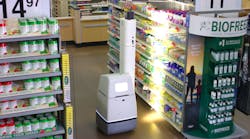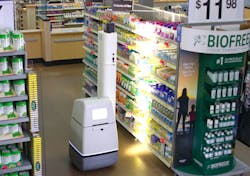Have you bumped into a robot in a store lately? If you don’t buy all your produce and products online, then you may run into one while shopping at a brick-and-mortar store like Walmart (see figure).
A number of factors have hastened this invasion of cobots. They range from frameworks like the Robot Operating System (ROS) to machine-learning (ML) inferencing to a host of smaller, low-cost sensors. Robots that used to have a couple sensors and maybe a camera or expensive LiDAR are enveloped in a mesh of sophisticated sensors these days.
Walmart is only one of many companies with stores that will have robots roaming the aisles looking at inventory.
Higher-resolution video, infrared, and thermal cameras are now available as are compact radar and LiDAR systems, often courtesy of the push for self-driving cars. The sensor net feeds deep-neural-network (DNN) models that provide planning software with ever-more detailed information about the local environment, including those pesky humans that tend to take offense when bumping into self-directed robots.
Neural networks are playing a rapidly increasing role in robotic systems, but they’re a far cry from Asimov’s fictional positronic brain—his three laws of robotics are still a bit in the future. Hardware acceleration is helping the adoption of ML technology, which is crucial because many applications, including robotics, require multiple ML models to process the sensor data streams. ML models are also being used for planning.
Neural networks are being employed in many components within cooperative robots, also known as cobots. Peaceful coexistence between cobots and humans will depend on how well designers can employ these tools and hardware to create cobots that perform their tasks while interacting with us and the rest of the world.
Cobots wandering around stores performing chores like inventory are just the start. There are smart suitcases that will follow you through the airport. Small delivery robots are being tested now. Some are rolling while others fly through the air. Not all cobots will be successful, but they will continue to improve and become more functional as developers take advantage of the latest hardware and software.



